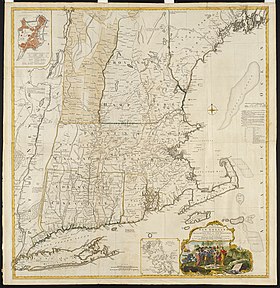TheEquivalent Landswere several large tracts of land that theProvince of Massachusetts Baymade available to settlers from theConnecticut Colonyafter April 1716. This was done as compensation for an equivalent area of territory that was under Connecticut's jurisdiction but had been inadvertently settled by citizens of Massachusetts.[1][2]: 137 The problem had arisen due to errors and imprecise surveys made earlier in the seventeenth century. The Equivalent Lands were never mapped.[3]

Background
editSettlers inSpringfield, Massachusetts,had several disagreements with settlers fromHartford, Connecticut,during the late 1630s when theConnecticut Colonywas just getting established. The Springfield settlers decided to align themselves with theMassachusetts Bay Colonyinstead of Connecticut.[4]As a result, Massachusetts Bay surveyed the border between Massachusetts and Connecticut in 1642, and took control of land as far south asWarehouse PointatWindsor Locks, Connecticut,the northernmost point on theConnecticut Rivercontrolled by the tides.
In the 1690s, Connecticut Colony officials performed their own survey and discovered errors that were made in Massachusetts's 1642 survey, but it was not until 1713 that the two colonies co-operated to survey correct boundaries. At that time, the surveyors found that Massachusetts Bay had offered Springfield settlers the right to 105,793 acres (428.13 km2) that actually belonged to Connecticut. The settlers had established themselves in and around the towns of Springfield,Westfield,Suffield,and other areas west of the Connecticut River and believed themselves to be in lands belonging to Massachusetts Bay.[5]Most of those inhabiting the area did not want to change jurisdiction from Massachusetts to Connecticut, so they agreed that Massachusetts would retain administration over the settled lands. In return, Connecticut would be granted property rights (but not sovereignty) for an equal number of acres within Massachusetts, "as an equivalent to the said colony".: 137–138 Connecticut began to auction off the "Equivalent Lands" in 1716, using most of the proceeds to fund the establishment ofYale College.
Settlement and further development
editThe surveys laying out the new tracts were concluded on November 10, 1715. One tract was in the area aroundPelhamandHadley,another in the area encompassingPutney,Brattleboro,andDummerston,and another along the east side of the Connecticut River. The commissioners appointed to locate these lands were Massachusetts GovernorJoseph Dudley;Connecticut GovernorGurdon Saltonstall;Massachusetts residents Elisha Hutchinson and Isaac Addington; and Connecticut residents William Pitkin and William Whiting. These tracts, known as the Equivalent Lands, were then made available for purchase at Hartford on April 24–25, 1716, with the proceeds going to establish Yale.[2]: 137–138 These auctioned lands were grouped in at least three known parcels; however, since there are no extant maps of the Equivalent Lands,[6]there may have been additional areas not auctioned at that time.
One group ofland speculatorspurchased a 44,000-acre (180 km2) parcel. This group includedWilliam Brattle, Jr.for whom Brattleboro, Vermont was named.[3]Other initial purchasers of the lands includedPaul Dudley,Thomas Fitch III, andJonathan Belcher.[7]
Founding of Brattleboro
editThe Massachusetts General Court voted on December 27, 1723 to build a blockhouse and stockade north of itsNorthfieldsettlement in order to defend theProvince of Massachusetts Bayagainst ChiefGray Lockand others duringDummer's War.Lieutenant-governorWilliam Dummersigned the measure, and construction ofFort Dummerbegan on February 3, 1724. It was completed before summer, and a force of about 70Native Americans,of the French-alliedAbenaki tribe,attacked it on October 11, killing three or four defenders.[8][9]The settlement surrounding the fort was called "Brattleborough".[8]
The fort was converted into a trading post in 1728 for commerce with friendly Indians. It was once again manned by soldiers duringKing George's Warfrom 1744 to 1748. A small body of troops remained at the fort until 1750, after which it was considered unnecessary. Brattleborough itself was only scarcely populated until after the 1763Treaty of Paris,whenFranceabandoned its attempts to colonize North America.[8]
Other settlements
editTheAshuelot Valleytowns ofUpper AshuelotandArlingtonwere established prior to 1740, with several families living in each of the settlements.[9]Richard Hazzen was sent to survey the area in the winter of 1740–41 to try to determine the boundary line between New Hampshire and Massachusetts Bay Colony.[3]
Some settlements in the Equivalent Lands were temporarily abandoned in the mid- to late-1740s due to renewed conflicts with the French and their allied tribes.[9]These areas around Fort Dummer at the time were regarded to be in theNew Hampshire colony,although maintenance and protection of the settlements were paid for by Massachusetts Bay. Therefore, another survey team was sent out in 1749, to once again clarify provincial lines, resulting in theNew Hampshire Grantsand the subsequent territorial disputes with theNew York Colonyconcerning jurisdiction over parts of the area and its inhabitants.[9]
In 1752, a large section of the area came under the dominion of theProvince of New Hampshire,but eventually fell underVermontjurisdiction.[2]: 252
The Equivalent Lands encompass parts of what are now Vermont, New Hampshire, Connecticut, and Massachusetts.[2]: 278–80
References
edit- ^Records held in office of the Secretary of the State of Connecticut;Colonial Boundaries, Vol. III; Massachusetts, 1670–1827.
- ^abcdCrockett, Walter Hill (1921).Vermont: The Green Mountain State.Vol. 1. New York: The Century History Company, Inc.
- ^abc"The Equivalent Lands and Fort Dummer".Brattleboro History.Valley Historians.RetrievedMarch 10,2017.
- ^Barrows, Charles Henry (1911).The History of Springfield in Massachusetts for the Young: Being also in some part the history of other towns and cities in the county of Hampden.Connecticut Valley Historical Society. pp. 46–48.
- ^Connecticut Boundary Survey;part 1 of 2Archived2014-07-14 at theWayback Machine
- ^Note: There is a written description of some of the Equivalent Lands in the Connecticut Archives.
- ^Hyde, William (1847).An Address, Delivered at the Opening of the New Town-Hall, Ware, Mass., March 31, 1847, Containing Sketches of the Early History of That Town, and Its First Settlers.Brookfield, Mass:Merriam and Cooke, Printers.
- ^abcCoolidge, A. J.; Mansfield, J. B. (1859).A History and Description of New England, General & Local.Vol. 1. Boston, Massachusetts: Austin J. Coolidge.
- ^abcdEquivalent Lands;webpage; Vermont History on-line; accessed April 26, 2020